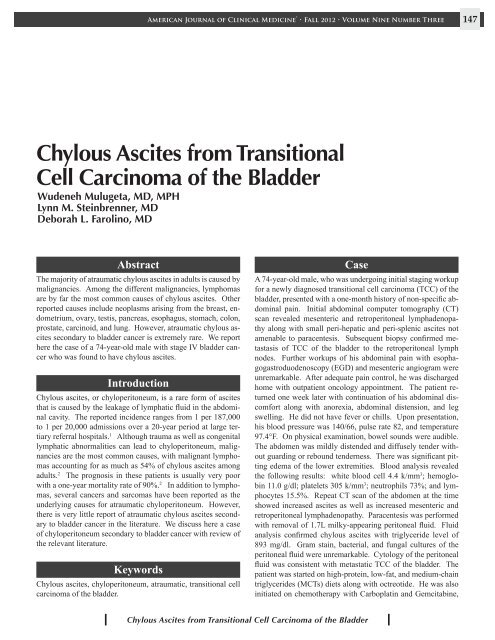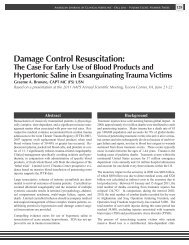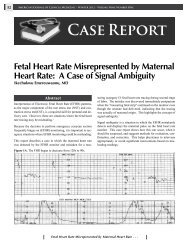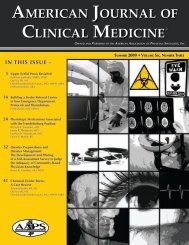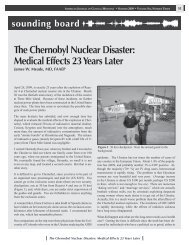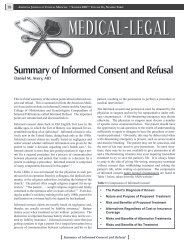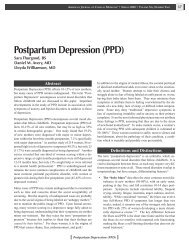Chylous Ascites from Transitional Cell Carcinoma of the Bladder
Chylous Ascites from Transitional Cell Carcinoma of the Bladder
Chylous Ascites from Transitional Cell Carcinoma of the Bladder
You also want an ePaper? Increase the reach of your titles
YUMPU automatically turns print PDFs into web optimized ePapers that Google loves.
American Journal <strong>of</strong> Clinical Medicine® • Fall 2012 • Volume Nine Number Three 147<br />
<strong>Chylous</strong> <strong>Ascites</strong> <strong>from</strong> <strong>Transitional</strong><br />
<strong>Cell</strong> <strong>Carcinoma</strong> <strong>of</strong> <strong>the</strong> <strong>Bladder</strong><br />
Wudeneh Mulugeta, MD, MPH<br />
Lynn M. Steinbrenner, MD<br />
Deborah L. Farolino, MD<br />
Abstract<br />
The majority <strong>of</strong> atraumatic chylous ascites in adults is caused by<br />
malignancies. Among <strong>the</strong> different malignancies, lymphomas<br />
are by far <strong>the</strong> most common causes <strong>of</strong> chylous ascites. O<strong>the</strong>r<br />
reported causes include neoplasms arising <strong>from</strong> <strong>the</strong> breast, endometrium,<br />
ovary, testis, pancreas, esophagus, stomach, colon,<br />
prostate, carcinoid, and lung. However, atraumatic chylous ascites<br />
secondary to bladder cancer is extremely rare. We report<br />
here <strong>the</strong> case <strong>of</strong> a 74-year-old male with stage IV bladder cancer<br />
who was found to have chylous ascites.<br />
Introduction<br />
<strong>Chylous</strong> ascites, or chyloperitoneum, is a rare form <strong>of</strong> ascites<br />
that is caused by <strong>the</strong> leakage <strong>of</strong> lymphatic fluid in <strong>the</strong> abdominal<br />
cavity. The reported incidence ranges <strong>from</strong> 1 per 187,000<br />
to 1 per 20,000 admissions over a 20-year period at large tertiary<br />
referral hospitals. 1 Although trauma as well as congenital<br />
lymphatic abnormalities can lead to chyloperitoneum, malignancies<br />
are <strong>the</strong> most common causes, with malignant lymphomas<br />
accounting for as much as 54% <strong>of</strong> chylous ascites among<br />
adults. 2 The prognosis in <strong>the</strong>se patients is usually very poor<br />
with a one-year mortality rate <strong>of</strong> 90%. 2 In addition to lymphomas,<br />
several cancers and sarcomas have been reported as <strong>the</strong><br />
underlying causes for atraumatic chyloperitoneum. However,<br />
<strong>the</strong>re is very little report <strong>of</strong> atraumatic chylous ascites secondary<br />
to bladder cancer in <strong>the</strong> literature. We discuss here a case<br />
<strong>of</strong> chyloperitoneum secondary to bladder cancer with review <strong>of</strong><br />
<strong>the</strong> relevant literature.<br />
Keywords<br />
<strong>Chylous</strong> ascites, chyloperitoneum, atraumatic, transitional cell<br />
carcinoma <strong>of</strong> <strong>the</strong> bladder.<br />
Case<br />
A 74-year-old male, who was undergoing initial staging workup<br />
for a newly diagnosed transitional cell carcinoma (TCC) <strong>of</strong> <strong>the</strong><br />
bladder, presented with a one-month history <strong>of</strong> non-specific abdominal<br />
pain. Initial abdominal computer tomography (CT)<br />
scan revealed mesenteric and retroperitoneal lymphadenopathy<br />
along with small peri-hepatic and peri-splenic ascites not<br />
amenable to paracentesis. Subsequent biopsy confirmed metastasis<br />
<strong>of</strong> TCC <strong>of</strong> <strong>the</strong> bladder to <strong>the</strong> retroperitoneal lymph<br />
nodes. Fur<strong>the</strong>r workups <strong>of</strong> his abdominal pain with esophagogastroduodenoscopy<br />
(EGD) and mesenteric angiogram were<br />
unremarkable. After adequate pain control, he was discharged<br />
home with outpatient oncology appointment. The patient returned<br />
one week later with continuation <strong>of</strong> his abdominal discomfort<br />
along with anorexia, abdominal distension, and leg<br />
swelling. He did not have fever or chills. Upon presentation,<br />
his blood pressure was 140/66, pulse rate 82, and temperature<br />
97.4°F. On physical examination, bowel sounds were audible.<br />
The abdomen was mildly distended and diffusely tender without<br />
guarding or rebound tenderness. There was significant pitting<br />
edema <strong>of</strong> <strong>the</strong> lower extremities. Blood analysis revealed<br />
<strong>the</strong> following results: white blood cell 4.4 k/mm 3 ; hemoglobin<br />
11.0 g/dl; platelets 305 k/mm 3 ; neutrophils 73%; and lymphocytes<br />
15.5%. Repeat CT scan <strong>of</strong> <strong>the</strong> abdomen at <strong>the</strong> time<br />
showed increased ascites as well as increased mesenteric and<br />
retroperitoneal lymphadenopathy. Paracentesis was performed<br />
with removal <strong>of</strong> 1.7L milky-appearing peritoneal fluid. Fluid<br />
analysis confirmed chylous ascites with triglyceride level <strong>of</strong><br />
893 mg/dl. Gram stain, bacterial, and fungal cultures <strong>of</strong> <strong>the</strong><br />
peritoneal fluid were unremarkable. Cytology <strong>of</strong> <strong>the</strong> peritoneal<br />
fluid was consistent with metastatic TCC <strong>of</strong> <strong>the</strong> bladder. The<br />
patient was started on high-protein, low-fat, and medium-chain<br />
triglycerides (MCTs) diets along with octreotide. He was also<br />
initiated on chemo<strong>the</strong>rapy with Carboplatin and Gemcitabine,<br />
<strong>Chylous</strong> <strong>Ascites</strong> <strong>from</strong> <strong>Transitional</strong> <strong>Cell</strong> <strong>Carcinoma</strong> <strong>of</strong> <strong>the</strong> <strong>Bladder</strong>
148<br />
American Journal <strong>of</strong> Clinical Medicine® • Fall 2012 • Volume Nine Number Three<br />
eventually completing five cycles. Repeat CT scan following<br />
five cycles <strong>of</strong> chemo<strong>the</strong>rapy showed some improvement <strong>of</strong> <strong>the</strong><br />
lymphadenopathy. Subsequent paracentesis also revealed substantial<br />
reduction in triglyceride level <strong>of</strong> <strong>the</strong> peritoneal fluid<br />
<strong>from</strong> 893 mg/dl to 240 mg/dl. Repeat cytology <strong>of</strong> <strong>the</strong> peritoneal<br />
fluid was found to be negative for malignancy. Unfortunately,<br />
our patient had multiple and prolonged hospitalizations complicated<br />
by urinary tract infection and recurrent Clostridium difficile<br />
colitis. The patient progressively deteriorated, and he died<br />
eight months later.<br />
Discussion<br />
The lymphatic system was discovered by <strong>the</strong> Italian physician<br />
Gasparo Aselli in 1622. 3 Although <strong>the</strong> first case <strong>of</strong> chylothorax<br />
was reported by Bartholin in 1651, it wasn’t until 1694, when<br />
Morton described <strong>the</strong> first case <strong>of</strong> chylous ascites. 3 <strong>Chylous</strong><br />
ascites refers to <strong>the</strong> presence <strong>of</strong> milky chyle in <strong>the</strong> peritoneal<br />
cavity. Previous studies have reported incidence <strong>of</strong> chylous<br />
ascites ranging <strong>from</strong> 1:187,000 to 1:20,000 admissions over a<br />
20-year period at major hospitals. 1 However, <strong>the</strong> incidence is<br />
believed to be increasing because <strong>of</strong> more aggressive thoracic<br />
and retroperitoneal surgery along with prolonged survival <strong>of</strong><br />
cancer patients. Some investigators have roughly categorized<br />
<strong>the</strong> causes <strong>of</strong> chylous ascites into traumatic and atraumatic. 4 In<br />
traumatic cases, blunt abdominal trauma or direct injuries <strong>from</strong><br />
surgical procedures can rupture lymphatic vessels, creating lymphoperitoneal<br />
fistula and chyloperitoneum. On <strong>the</strong> o<strong>the</strong>r hand,<br />
atraumatic chylous ascites manifests when <strong>the</strong> lymph flow is<br />
obstructed by non-traumatic causes, such as malignancies, infections,<br />
or congenital abnormalities. The most common causes<br />
<strong>of</strong> atraumatic chylous ascites among adults are malignancies.<br />
Malignancies can cause lymph flow obstruction by extrinsic<br />
compression or direct invasion. The majority (as much as 54%)<br />
<strong>of</strong> <strong>the</strong> malignancies causing chylous ascites are lymphomas. 1,2<br />
<strong>Carcinoma</strong>s <strong>of</strong> <strong>the</strong> breast, endometrium, ovary, testis, pancreas,<br />
esophagus, stomach, colon, prostate, carcinoid, and lung have<br />
also been reported as causes <strong>of</strong> chyloperitoneum. 1,2,4 However,<br />
atraumatic chylous ascites secondary to bladder cancer is extremely<br />
uncommon. In our Medline search (using PubMed)<br />
<strong>of</strong> <strong>the</strong> literature, we found very few reports <strong>of</strong> chylous ascites<br />
associated with bladder cancer. This is consistent with o<strong>the</strong>r<br />
large case series and meta-analysis studies, which did not find<br />
atraumatic chylous ascites caused by bladder cancer. 2,4,5 A possible<br />
explanation for this observation is <strong>the</strong> fact that <strong>the</strong> vast<br />
majority <strong>of</strong> patients with bladder cancer tend to present at early<br />
stages <strong>of</strong> <strong>the</strong> disease. According to data released by <strong>the</strong> National<br />
Cancer Institute (NCI) in 2012, nearly 86% <strong>of</strong> bladder cancers<br />
are ei<strong>the</strong>r in situ or localized to <strong>the</strong> primary site at <strong>the</strong> time <strong>of</strong><br />
<strong>the</strong>ir diagnosis. 6 Unfortunately, our patient had advanced bladder<br />
cancer with metastasis to <strong>the</strong> mesenteric and retroperitoneal<br />
lymph nodes leading to chyloperitoneum. Patients with chylous<br />
ascites can present with abdominal distension, non-specific<br />
abdominal pain, anorexia, weakness, and edema. To make a<br />
definitive diagnosis <strong>of</strong> chylous ascites, paracentesis should be<br />
performed for peritoneal fluid analysis. Some <strong>of</strong> <strong>the</strong> main characteristics<br />
<strong>of</strong> chyle include milky appearance, alkaline chemical<br />
property, specific gravity greater than 1.012, and staining <strong>of</strong> fat<br />
globules with Sudan Red stain. 1 Although <strong>the</strong>re is no set criteria<br />
to make <strong>the</strong> diagnosis <strong>of</strong> chyloperitoneum, measuring <strong>the</strong><br />
triglyceride level is critical. The triglyceride levels are typically<br />
> 200 mg/dl, and some authors have used 110 mg/dl as a cut <strong>of</strong>f<br />
value. 1,7 Management <strong>of</strong> chylous ascites includes high-protein<br />
and low-fat diets with MCTs to improve nutritional status and<br />
reduce chyle formation. Although no treatment guidelines exist,<br />
several case reports have demonstrated benefits <strong>from</strong> using<br />
octreotide. 8 Ultimately, <strong>the</strong> treatment as well as <strong>the</strong> prognosis <strong>of</strong><br />
chylous ascites depends on <strong>the</strong> underlying disease process. For<br />
patients with chylous ascites caused by malignancies, <strong>the</strong> prognosis<br />
is usually very poor with <strong>the</strong> three-month and one-year<br />
mortality <strong>of</strong> 52% and 90%, respectively. 2 Unfortunately, our<br />
patient had advanced bladder cancer with multiple complications<br />
and partial response to treatment.<br />
Wudeneh Mulugeta, MD, MPH, is a second year Internal Medicine/Social<br />
and Preventive Medicine Resident at <strong>the</strong> State University<br />
<strong>of</strong> New York (SUNY) at Buffalo.<br />
Lynn M. Steinbrenner, MD, is Clinical Associate Pr<strong>of</strong>essor <strong>of</strong><br />
Hematology/Oncology, Department <strong>of</strong> Medicine at <strong>the</strong> State<br />
University <strong>of</strong> New York (SUNY), Buffalo, and Chief <strong>of</strong> Hematology<br />
and Oncology at <strong>the</strong> Veterans Administration (VA) Western<br />
New York Healthcare System at Buffalo.<br />
Deborah L. Farolino, MD, is Clinical Assistant Pr<strong>of</strong>essor <strong>of</strong><br />
Hematology/Oncology, Department <strong>of</strong> Medicine at <strong>the</strong> State<br />
University <strong>of</strong> New York (SUNY) at Buffalo.<br />
Potential Financial Conflicts <strong>of</strong> Interest: By AJCM ® policy, all authors<br />
are required to disclose any and all commercial, financial, and o<strong>the</strong>r<br />
relationships in any way related to <strong>the</strong> subject <strong>of</strong> this article that might<br />
create any potential conflict <strong>of</strong> interest. The author has stated that no<br />
such relationships exist.<br />
References<br />
1. Aalami OO, Allen DB, Organ CH Jr. <strong>Chylous</strong> ascites: a collective review.<br />
Surgery. 2000;128:761–778.<br />
2. Press OW, Press NO, Kaufman SD. Evaluation and management <strong>of</strong><br />
chylous ascites. Ann Intern Med. 1982;96:358–364.<br />
3. McCarthy H, Organ CJ. Chyloperitoneum. Arch Surg. 1958;77:421-32.<br />
4. Steinemann DC, Dindo D, Clavien PA, Nocito A. Atraumatic chylous<br />
ascites: systemic review on symptoms and causes. J Am Coll Surg.<br />
2011;212(5):899-905.<br />
5. Vasko J, Tapper R. The surgical significance <strong>of</strong> chylous ascites. Arch Surg.<br />
1967;95:355-68.<br />
6. Howlader N, Noone AM, Krapcho M, Neyman N, Aminou R, Altekruse<br />
SF, Kosary CL, Ruhl J, Tatalovich Z, Cho H, Mariotto A, Eisner MP,<br />
Lewis DR, Chen HS, Feuer EJ, Cronin KA (eds). SEER Cancer Statistics<br />
Review, 1975-2009 (Vintage 2009 Populations), National Cancer Institute.<br />
Be<strong>the</strong>sda, MD, http://seer.cancer.gov/csr/1975_2009_pops09/, based on<br />
November 2011 SEER data submission, posted to <strong>the</strong> SEER web site,<br />
2012.<br />
7. Almakdisi T, Massoud S, Makdisi G. Lymphomas and chylous ascites:<br />
Review <strong>of</strong> <strong>the</strong> literature. The Oncologist. 2005;10:632-635.<br />
8. Mincher L, Evans J, Jenner MW, Varney VA. The successful treatment <strong>of</strong><br />
chylous effusions in malignant disease with octreotide. Clin Oncol (R Coll<br />
Radiol). 2005;17:118.<br />
<strong>Chylous</strong> <strong>Ascites</strong> <strong>from</strong> <strong>Transitional</strong> <strong>Cell</strong> <strong>Carcinoma</strong> <strong>of</strong> <strong>the</strong> <strong>Bladder</strong>


